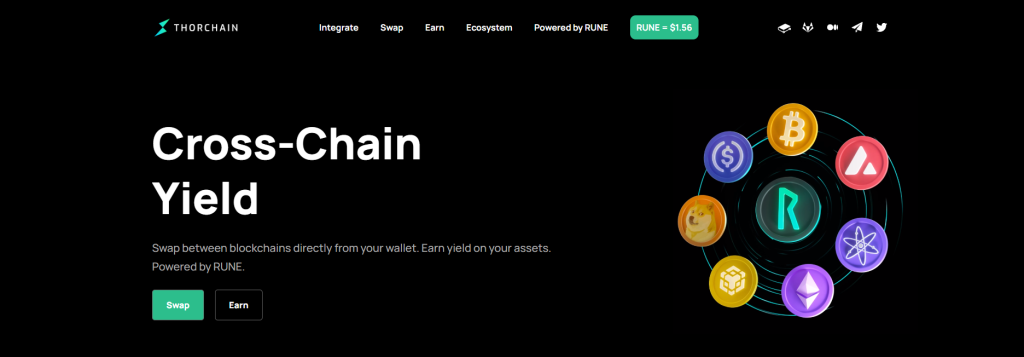
Bridging Bitcoin to Ethereum refers to the process of transferring BTC from the Bitcoin blockchain onto the Ethereum blockchain. This allows Bitcoin holders to access the Ethereum network and participate in decentralized finance (DeFi) applications built on Ethereum.
There are two main methods for bridging BTC to Ethereum:
- Wrapping BTC into an ERC-20 token via services like WBTC, RenBTC or tBTC
- Performing a native swap of BTC directly to ETH via DEXes like RocketXchange or Thorswap
- Using centralized exchanges like Binance or Coinbase to convert BTC to WBTC
Wrapping effectively locks up your BTC and mints a new ERC-20 token to represent your BTC on Ethereum. This allows your BTC to interact seamlessly with smart contracts and dApps on Ethereum.
Swapping refers to exchanging your BTC for ETH directly by utilizing liquidity pools and exchange protocols. This converts your BTC to ETH so you can use the ETH natively on the Ethereum blockchain.
What you'll learn 👉
Wrapping BTC into an ERC-20 Token
Wrapped Bitcoin (WBTC), renBTC, and tBTC are three popular ERC-20 token protocols for wrapping BTC on Ethereum. Here’s an overview of each:
Wrapped Bitcoin (WBTC)
Wrapped Bitcoin is an ERC-20 token backed 1:1 with Bitcoin. The process involves BTC being locked up in a custodial manner and WBTC tokens generated to represent that BTC on Ethereum.
Anyone can initiate the minting process by sending BTC to WBTC’s custodian, BitGo. BitGo will then verify the BTC and signal the minting of an equal amount of WBTC, which is sent to the user’s Ethereum address.
The process is reversed when burning WBTC to unlock the BTC. WBTC is sent to a burning address, triggering BitGo to release the equal amount of BTC from custody.
✔️ WBTC benefits:
- Allows BTC to be used in Ethereum DeFi apps for lending, borrowing, liquidity pools etc.
- Pegged 1:1 to BTC, so maintains equal value
- Backed by full bitcoin reserves, providing transparency
- Integration with major DeFi protocols like Compound, MakerDAO, Uniswap etc.
- Strong legal protections through custodian agreements
❌ Drawbacks:
- Requires KYC identity verification for minting/burning
- Centralized through BitGo custodianship
- Risk of mismanagement by custodian
tBTC
tBTC aims to bring Bitcoin to Ethereum in a decentralized, permissionless and trust-minimized manner. Users initiate minting by sending BTC to the tBTC protocol smart contracts.
A group of participants called signers then facilitate the BTC to tBTC swap. Signers take custody of the BTC and mint tBTC on Ethereum to the user’s address.
To provide security, signers must stake ETH as collateral. Additionally, “keepers” monitor the system and can trigger slashing of signer bonds if they act maliciously.
✔️ tBTC benefits:
- Decentralized, no KYC needed
- Non-custodial, users control private keys
- Signers and keepers provide security
- Open access, anyone can integrate tBTC
- Growing adoption on Ethereum DeFi platforms
❌ Drawbacks:
- Complex system with many moving parts
- Security dependent on collateral stakes
- Low market cap and liquidity relative to WBTC
Read also:
- How and Where to Stake Solana (Full Guide)
- Best Decentralized Exchanges (DEXes) on Shibarium: Top Shibarium DEX
- How to Get Friend.tech Airdrop: Everything You Need to Know About the Friend.tech Airdrop
Native Swaps of BTC to ETH
Rather than wrapping BTC into a token, another option is to directly swap BTC for ETH using atomic swap protocols. This converts your BTC into ETH so you can interact natively with the Ethereum blockchain.
Popular decentralized exchange protocols for trustless BTC to ETH swaps include THORChain and RocketXchange.
THORChain
THORChain is a decentralized liquidity network that facilitates native swaps between different blockchain assets using decentralized liquidity pools.

To swap BTC for ETH on THORChain:
- Visit app.thorswap.finance
- Connect your wallet containing BTC
- Select BTC as the input asset and ETH as the output asset
- Review swap details and submit the transaction
- Complete any wallet confirmation prompts
Your BTC will be exchanged directly for ETH using THORChain’s liquidity pools. The ETH can then be used seamlessly on Ethereum without any wrapping required.
✔️ THORChain benefits:
- Direct swap of assets, no wrapping tokens
- Non-custodial, you hold private keys
- No intermediaries or kyc
- Fast, cross-chain trading
- Growing liquidity pools and adoption
❌ Drawbacks:
- Limited coin availability compared to DEX aggregators
- Complex protocol reliant on validators
- Slashing risks if validators misbehave
RocketXchange
RocketXchange is a DEX aggregator that sources liquidity from both centralized and decentralized exchanges to provide the best swap rates across chains.

To use RocketXchange to swap BTC to ETH:
- Visit rocketx.exchange
- Connect wallet containing your BTC
- Select BTC as input asset and ETH as output asset
- Review estimated swap rates across multiple sources
- Execute swap through the best rate
- Confirm any wallet prompts to complete transaction
RocketXchange will automatically direct your swap through the most optimal exchange rate for BTC/ETH. This provides trustless, no KYC swaps between the assets.
✔️ RocketXchange benefits:
- Swaps assets directly, no wrapping required
- Aggregates liquidity across CEXs and DEXs
- Finds best rates to optimize swaps
- Intuitive interface for easy swapping
- Non-custodial, users maintain asset control
❌ Drawbacks:
- Reliant on external exchanges
- Swap execution can be complex
- Liquidity fragmentation across exchanges
- Limited coin availability
How to Bridge BTC to ETH: A Simple Step-by-Step Guide
Moving Bitcoin (BTC) to Ethereum (ETH) isn’t as direct as swapping tokens on the same chain. Because Bitcoin and Ethereum run on different networks, you’ll need to use a cross-chain bridge to move assets between them. Here’s how it works:
1. Pick a Bridge Platform
Start by choosing a trusted bridge that supports Bitcoin-to-Ethereum transfers. Platform like RocketExchange is popular nowadays. Just keep in mind that fully decentralized BTC-ETH bridges don’t exist yet – most require some level of trust in a custodian or smart contract system.
2. Connect Your Wallet
You’ll need wallets for both Bitcoin and Ethereum.
For Ethereum, MetaMask is a popular choice.
For Bitcoin, some bridges won’t let you connect a wallet directly – instead, they’ll ask you to enter your BTC address manually when sending funds.
3. Set Up the Transfer
Choose BTC as the token you want to send.
Set Ethereum as the destination network.
You’ll usually receive a wrapped version of Bitcoin on Ethereum, like WBTC or tBTC, which is an ERC-20 token.
Enter your Ethereum wallet address to receive the tokens.
4. Review and Confirm
Double-check the amount you’ll receive and look over any fees.
Bridge platforms usually charge a small fee, and you’ll also need to pay Ethereum gas fees – which can vary depending on network congestion.
Once you’re ready, confirm the transaction and send your BTC to the bridge’s address.
5. Wait for the Transfer
The bridge will process your BTC transaction and then release or mint the equivalent amount of ERC-20 BTC to your Ethereum wallet. This usually takes a few minutes, but it can vary.
6. Check Your Wallet
If your new tokens don’t show up right away, make sure your wallet is on the Ethereum network.
You might also need to manually add the token’s contract address to your wallet to see the balance.
Using centralized exchanges
Another option for bridging Bitcoin to Ethereum is utilizing centralized crypto exchanges (CEXs) as an intermediary. This involves first depositing BTC into a CEX account, trading the BTC for ETH on the exchange order books, and then withdrawing the ETH to an Ethereum wallet address you control.
Major exchanges like Binance, Coinbase, and Kraken allow seamless trading between BTC and ETH trading pairs. The ETH received can then be used natively on the Ethereum blockchain for transactions and dApps.
Alternatively, some centralized exchanges like Binance support direct withdrawals of BTC as wrapped assets like WBTC on the Ethereum network. For example, you can deposit BTC to Binance, and then withdraw those funds as WBTC directly to your Ethereum wallet. This combines the speed and liquidity of a CEX with the interoperability of wrapped BTC in a single seamless transfer.
The benefits of bridging BTC to ETH via CEXs include fast settlement speeds, high liquidity, and simple user interfaces. However, centralization risks and lack of custody mean users must trust the exchange to facilitate the bridge properly. Decentralized bridges offer superior transparency and user control, but may have lower liquidity and slower swap execution.
Conclusion
Bridging Bitcoin to Ethereum can be accomplished through either wrapping BTC into an ERC-20 token or performing a direct atomic swap into ETH. WBTC, renBTC and tBTC are leading wrapping solutions, each with their own merits and tradeoffs. THORChain and RocketXchange allow trustless swapping of BTC into ETH without tokenization.
The optimal method depends on factors like the application you intend to use ETH for, importance of decentralization, and required transaction speed. But overall, BTC to ETH bridges greatly expand Bitcoin’s potential use cases by bringing its liquidity and value onto the Ethereum DeFi ecosystem.







